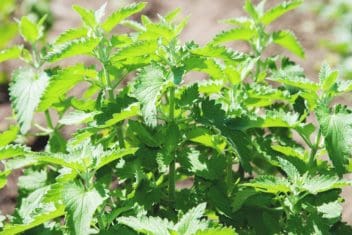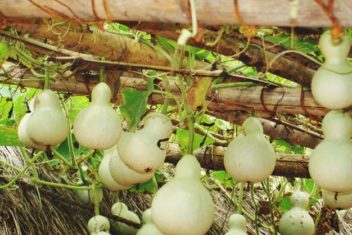Motherwort (Leonurus cardiaca) is a favorite medicinal herb that grows wild near streams or rivers from southern Canada to the east of the Rocky Mountains. It’s has a reputation as a rapidly spreading weed because it can grow basically anywhere, whether in a neglected garden or deep in the woods. Motherwort grows wild along riverbanks, fields, meadows, and more, so it’s no surprise that it’s known as an invasive plant.
Don’t let that put you off of growing motherwort. Handled properly, it can be a powerful addition to the garden and your medicine cabinet.
Historically, motherwort has been used medicinally for menstruation challenges, along with nervous and anxiety issues. There’s also evidence it can help with alcoholism and menopause. It’s called motherwort because it was traditionally used during the postpartum weeks. But even if you aren’t interested in its medicinal properties, gardeners plant motherwort because it attracts all sorts of bees and pollinators to your garden. You can also eat motherwort.
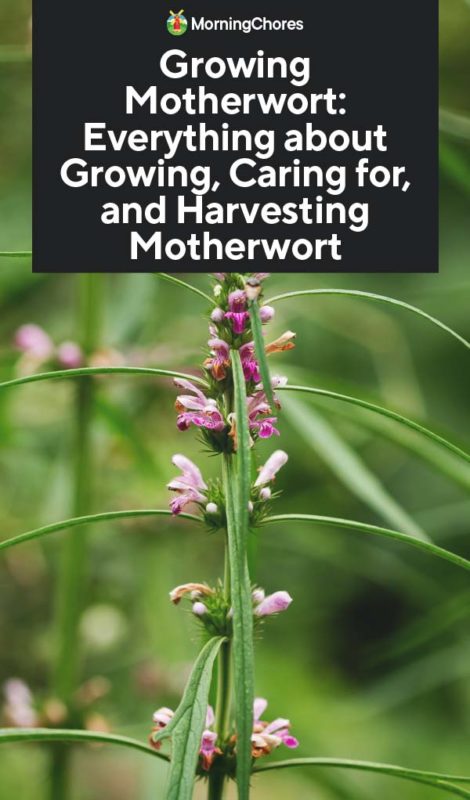
How to Grow Motherwort
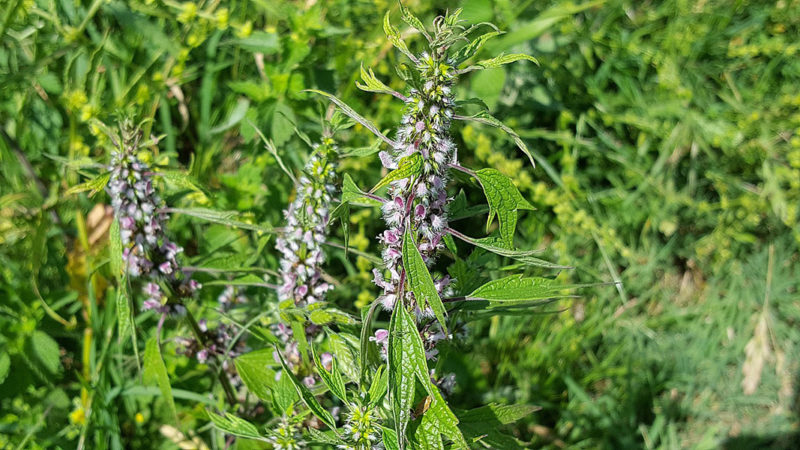
Motherwort is a sturdy, stemmed perennial that grows up to 5 feet tall with pink or purple clustered flowers. The flowers have 6-15 axils and appear from July to September. The lower leaves of the plant have 5 cleft lobes with coarse teeth. As you go up the stem, the leaves have 3 cleft lobes, while the upper leaves are oblong with a pair of coarse teeth.
Growing Zones
Motherwort is a perennial herb that grows in USDA hardiness zones 4-8.
Stratify Seeds
In order to start growing motherwort, the seeds to be stratified for several weeks before they will sprout. Some gardeners sow seeds outside in the garden in late fall, allowing winter to do the stratification for them.
You can also manually stratify seeds. To do that, you need to give seeds a period of cold treatment for a few weeks. This tricks the seeds into thinking they’ve been through a period of winter, and it’s time to grow now that its spring.
How to Stratify Seeds
Growing motherwort seeds require cold stratification. The trick to stratification indoors is that you need to mimic the exact conditions a seed experiences in nature, and your kitchen isn’t nature.
To make this happen, soak the seeds for 12-24 hours, then put them in a plastic bag with equal amounts of sand and peat. Seal that bag and put it in the refrigerator for 10 days. Keep the sand and peat mixture moist, so check often.
Seeds may need up to a month to sprout, but if any do sprout while in the bag, be sure to plant them immediately. After a month, plant seeds in soil.
Starting Motherwort Seeds
Gardeners can either start the seeds outside in the garden or inside for transplanting. If you want to start the seeds inside, plant them a few weeks before the final frost date in your area.
Regardless of which you choose, place stratified seeds 1/8-inch deep in prepared soil. You don’t want to cover the seeds with too much dirt, or they won’t germinate and sprout.
Germinating Seeds
Make sure to keep the soil moist throughout germination. Expect germination to take a week when the soil temperatures are around 65-75℉. Once they’ve sprouted, thin plants to 2-3 feet apart.
Picking the Right Area
Motherwort is part of the mint family, and like mint, it grows nearly anywhere. That can be positive or negative. One thing to consider is that motherwort loves to self-seed. You want to pick a place that you don’t mind some extra plants popping up the next year, or a spot where you can keep it contained. Many people prefer to grow motherwort in pots to keep the plant coraled.
Sun Requirements
One of the best things about motherwort is it’s such a forgiving plant. Motherwort can grow in sunny or densely shady areas or anything in between.
The Right Conditions for Motherwort
Growing motherwort can happen in all kinds of soil conditions. It does best in moist, rich soils. The soil should be light and well-draining with a pH level of 7.7. That said, it can also manage in less-than-ideal conditions.
It’s best to lay down compost in the area where you want to plant the motherwort. Compost will add nutrients to your earth and help to increase drainage. If your soil is particularly clay-like, try adding some sand to help with drainage. Sand adds air circulation.
Transplanting
If you started your seeds inside, or if you purchased starters, put plants into your prepared garden beds after the danger of frost passes. The seedlings should be 4-6 inches tall before transplanting and leave at least 1 foot between plants.
Pick your perfect spot and dig a hole twice the width of your root ball. Take out your seedling and spread the roots out gently. Place in the hole, cover it with dirt, and water deeply to set the plant in place properly.
How to Care for Motherwort
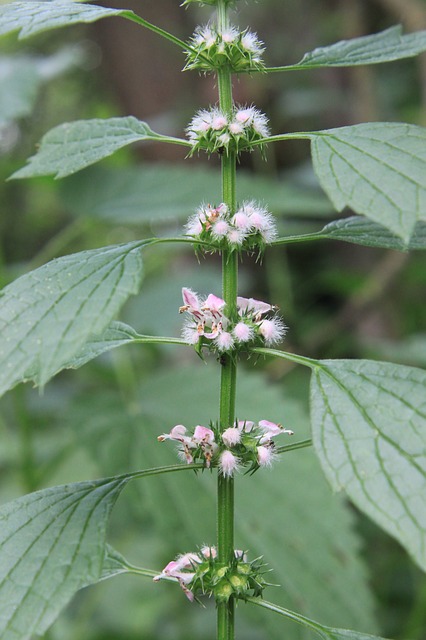
Growing motherwort is easy once you get the seeds sprouted. Since it grows wild in most areas, you could plant and let it go, but that won’t guarantee you’ll have the best results.
Watering
After you plant the motherwort in your garden, water the plants every 2-3 days until they grow larger. Once the plant is mature, it can withstand drier conditions. After established, motherwort is drought tolerant, but for the most potent plant, keep it well watered.
Fertilizing
Motherwort’s easy-going nature means that you don’t have to fertilize the plants unless you want to. For best results, use a 10-10-10 general fertilizer to ensure the soil has all the proper nutrients needed for healthy growth.
Trimming
Motherwort grows long stems on which the flowers bloom. Trim back the flowering tops to stop the plants from self-seeding all over your garden. If you want to use the plant for medicinal purposes, harvesting should take place when the plant is blooming.
Division of Plants
Motherwort grows quickly, which means you can dig them up and spread them around if you want. Divide plants in spring or fall when plants are dormant and temperatures aren’t too cold.
Problems With Growing Motherwort
Motherwort doesn’t have any issues with pests or diseases.
How to Harvest and Store Motherwort

Harvesting motherwort is fairly easy because the entire herb can be harvested after flowering. The dried plant is made into tinctures or teas that can be used for menopausal symptoms, painful periods, and gas. It also shows promise as a remedy for heart palpitations and high blood pressure.
Harvest leaves when the plant is in full bloom or just after. This is the best time to collect because research shows that the active ingredients of the plant are highest at this time. Snip to the base of the plant when its in full bloom. Motherwort flowers as early as June and will continue to bloom until it frosts.
Be aware that the spirals have thorns on them, so use gardening gloves and a pair of pruners.
Use fresh or dried flowers in soups like lentil or split pea. Fresh motherwort can be used as a flavoring for beer, and to make teas.
To store your motherwort, hang it to dry in an airy, dark place or use a dehydrator to dry it out faster. Once dried, store the motherwort in an airtight container like a glass jar.
Once dried, you can use the herb to make tinctures by steeping the dried herbs in high proof vodka. Make a tea with the leaves, letting them steep in hot water for 10 to 15 minutes.




